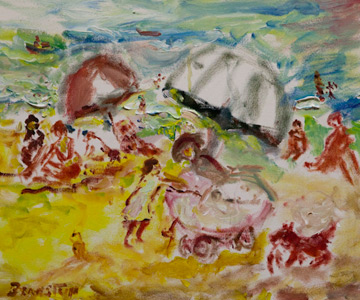By Philip I. Rosenbaum
Associated Press Writer
NEW YORK (AP) – Some 80 years ago, Theresa Bernstein’s art school instructor stopped at her easel to examine a sketch she worked on for six weeks. He took one look at it, raised his charcoal pencil and drew a big X across the paper.
Then he threw it in the waste-basket.
The teacher’s reverse psychology worked; Bernstein rebelled and fought even harder to turn her artistic promise into great talent.
“Some of the kids would be so upset they’d go out in the hall to wipe their tears. I would say, ‘Damn him, I’m going to do it again,’ and I’d do it over,” she said.
“I wasn’t so easily pained. If you’re not tough you can’t succeed in any given profession.”
Bernstein’s just as adamant about keeping her age a secret.
She tells close friends that she fears people don’t want to see old people’s art. She tells journalists she doesn’t know the precise year she was born. After much gentle prodding, she conceded her age falls somewhere between 101 and 105.
At one of Bernstein’s exhibits in New York, the late artist Georgia O’Keeffe once told Bernstein her paintings de-pict the dead while Bernstein’s capture the living.
“She was right,” Bernstein told a friend years later at an O’Keeffe exhibit in Los Angeles.
“Human nature has been my greatest book,” Bernstein said during a recent interview in her Manhattan loft, a cav-ernous, cluttered space that serves as her studio and looks like an old museum where the works have yet to be hung.
“I got a great enjoyment out of people and most artists resent intrusions of other elements in their life.”
But publicity and fame have never been her driving forces. Even now, in the twilight of her career, she values her privacy.
Despite four cataract operations, she still paints watercolor floral arrangements and sketches studies of a painting she did in 1917, “Waiting Room – Employment Office,” which depicts immigrants awaiting their first opportunity to work in the United States.
“The new citizens of this country were really an inspiration for me,” she said. “I felt these people were strangers in a strange land and they used to call them greenhorns.
“And I felt that the greenhorns were the ones that made the pillars of America stand up.”
Several other themes surfaced in her early works. Bernstein’s suffrage parade studies of 1912 culminated in a series of works from 1916 to 1919 that document the patriotic displays prompted by World War I.
Her paintings widened the range of topics often associated with The Ashcan School, a group of men, including art-ist John Sloan, who painted realism in everyday American street life.
A settlement house kindergarten teacher, immigrant women seeking domestic work, and milliners plying their trade were among the subjects of Bernstein’s New York Realism.
“Whenever a thing was compositionally right for a certain space I had to give it my best effort, my most brilliant technique, everything I could muster to make that space important,” Bernstein said.
She still attends gallery exhibits, where collectors put her works on sale for well into the five-figure mark. At a re-cent Madison Avenue show, she greeted a visitor with a personal sales pitch.
“What’s that book you’re holding?” she asked him. “Why isn’t it mine?”
When her husband, artist William Meyerowitz, died in 1981, Bernstein began to write his biography, “The Artist Speaks.” She later wrote “The Poetic Canvas,” a collection of her poetry, which she cheerfully recites from memory. Her own memoirs are soon to be published.
Earlier this year, the Museum of the City of New York held a four-month exhibition featuring 41 of her works from the first two decades of this century.
Born in Philadelphia, Bernstein was the only child of European immigrants. In 1907, she enrolled at the Philadel-phia School of Design for Women and graduated in 1911.
Bernstein recalled in animated detail an experience that shaped the artist she would become. She was chosen to par-ticipate in a competition at her art school. The prize: three years of study in England or France.
“Being ambitious and stupid, I simply chose the greatest subject of them all: Adam and Eve being expelled from the Garden of Eden by the Angel of the Lord.”
After 5 weeks, she finished the painting and left it in the studio to dry. “I come back the next morning, no painting. From that day to this I never found that painting.”
Bernstein offered a reward even though she had nothing to give.
“After a day of ruminating and asking everybody and everybody putting their innocent eyes up and saying, ‘Oh, I have no idea,’ I said to myself, ‘This is a plot. They don’t want me to win the competition so they took away my entry. I’m going to fool them.”‘
Bernstein found another canvas and, without eating or sleeping for two days, painted the whole thing from memory in a “fever of expression.”
She won the competition.
“Everybody was suddenly my great friend.”
A few days later the donor who sponsored the competition for the last 25 years had just died, and she learned he made no provision for the money in his will.
“I made up my mind then that fate had decreed that I do not study abroad, and I never did,” she said.”This way I made up my mind that I was going to paint American and nothing else.”

